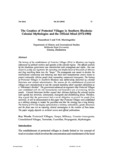Please use this identifier to cite or link to this item:
https://cris.library.msu.ac.zw//handle/11408/699Full metadata record
| DC Field | Value | Language |
|---|---|---|
| dc.contributor.author | Mazambani, Ishmael | - |
| dc.contributor.author | Mashingaidze, Terence M. | - |
| dc.date.accessioned | 2015-10-02T16:08:34Z | - |
| dc.date.available | 2015-10-02T16:08:34Z | - |
| dc.date.issued | 2014 | - |
| dc.identifier.issn | 1815-9036 | - |
| dc.identifier.uri | http://hdl.handle.net/11408/699 | - |
| dc.description.abstract | The history of the establishment of Protected Villages (PVs) in Rhodesia was largely influenced by political motives and agendas of the colonial regime. The official position by the Rhodesian government was characterized with propaganda and myths. This was meant to justify and legitimize the uprooting and displacement of thousands of Africans and frog marching them into the “keeps.” The propaganda was meant to deceive the international community into believing that these were humanitarian centers meant to protect vulnerable African people from marauding communist insurgents. The history of Protected Villages in Southern Rhodesia was deliberately distorted by colonial historians and colonial administrators. The reasons for the establishment of protected villages were manufactured to suit the colonial mentality which regarded colonialism as a “Whiteman’s Burden”. The government advanced an argument that Protected Villages were established with the sole humanitarian and benevolent aim of protecting African people. Colonial historians further argued that Africans fighting the colonial system were agenda less terrorists, communists, insurgents and destabilizing forces. Therefore, they argued that the government had a moral obligation to protect its people from terrorists. It will be demonstrated in this paper that Protected Villages were established as a military strategy to isolate the guerrillas and that the strategy has a long history. The history of PVs was largely captured from a military, nationalistic, gender dimension and the focus was not on exposing colonial shenanigans in the creation of these keeps. The paper largely depends on archival source and official publications. | en_US |
| dc.language.iso | en | en_US |
| dc.publisher | Midlands State University | en_US |
| dc.relation.ispartofseries | The Dyke;Vol. 8, No. 3; p. 72- 92 | - |
| dc.subject | Protected villages, keeps, military, counter-insurgents, consolidated villages, terrorists, guerrillas, propaganda, mythologies. | en_US |
| dc.title | The creation of protected villages in Southern Rhodesia: colonial mythologies and the official mind (1972-1980) | en_US |
| dc.type | Article | en_US |
| item.cerifentitytype | Publications | - |
| item.fulltext | With Fulltext | - |
| item.openairetype | Article | - |
| item.openairecristype | http://purl.org/coar/resource_type/c_18cf | - |
| item.grantfulltext | open | - |
| item.languageiso639-1 | en | - |
| Appears in Collections: | Research Papers | |
Files in This Item:
| File | Description | Size | Format | |
|---|---|---|---|---|
| mazambani.pdf | 11.47 MB | Adobe PDF |  View/Open |
Page view(s)
134
checked on Aug 21, 2025
Download(s)
144
checked on Aug 21, 2025
Google ScholarTM
Check
Items in MSUIR are protected by copyright, with all rights reserved, unless otherwise indicated.



